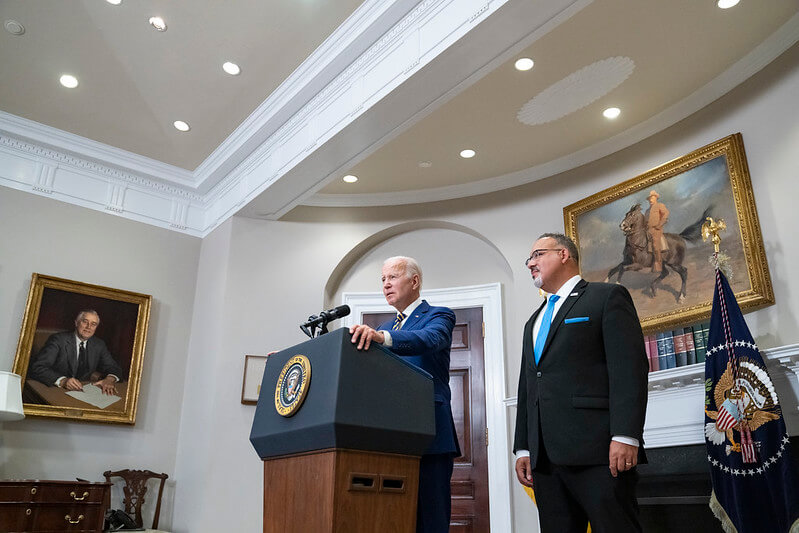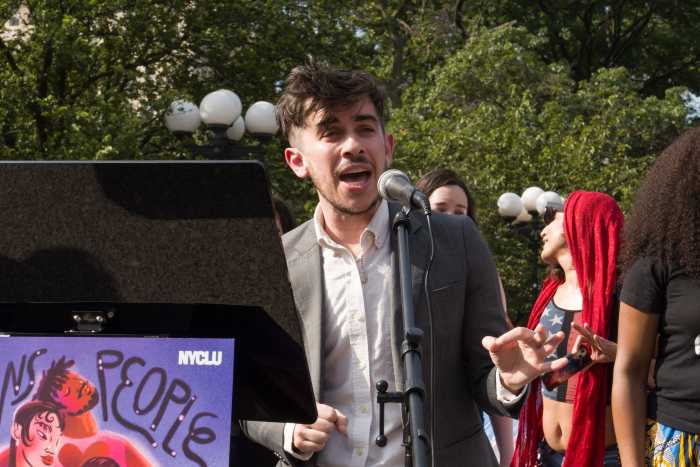At the end of March, the US Department of Education (DOE) announced that after two years of study and deliberation, it had decided to propose an addition to the Title IX Regulation concerning sports teams at educational institutions (K-12 and higher education) that receive federal financial assistance, directly addressing the issue of participation by transgender students. Title IX, enacted in 1972, forbids such institutions from discriminating “on the basis of sex.” Whether this provision prohibits discrimination against transgender students has stirred disagreement in the federal courts, and the Supreme Court has yet to address the issue on the merits.
The Obama administration published guidance, following the reasoning of the Equal Employment Opportunity Commission in a 2012 decision under Title VII, contending that Title IX bans discrimination because of gender identity. The Trump administration rescinded that guidance, and asserted to the contrary, even after the Supreme Court’s ruling in Bostock v Clayton County, described below. The Biden administration has proposed a new rule to replace the one issued by the Trump Administration.
The existing regulation, 23 C.F.R. Section 106.41(b), predating the current controversy, says that schools may establish separate teams for male and female students without violating the non-discrimination requirement, “where selection for such teams is based upon competitive skill or the activity involved is a contact sport.” The hotly debated question now is whether transgender girls and women should be considered “female” for this purpose. Some states have said yes, many have said no, and about 20 states have already passed statutes banning transgender women from participating in women’s sports across the board. Litigation has focused mainly on transgender women who want to compete in swimming, cross-country and track events, non-contact sports.
When Joe Biden became president in January 2021, he issued executive orders asserting that the Supreme Court’s ruling in Bostock v. Clayton County, in which the Court held that discrimination against a person because of their transgender status was sex discrimination under Title VII of the Civil Rights Act of 1964, should be applied, “where appropriate,” to all federal laws banning discrimination because of sex. He directed the various executive branch departments and agencies to consider how this would apply to the laws they interpreted and enforced, and directed them to adopt appropriate policies and, where needed, regulations.
The Education Department responded quickly, publishing guidance documents that spring asserting that Title IX’s ban on discrimination “on the basis of sex” would be interpreted in accordance with the reasoning of the Bostock decision. However, the department also announced that it considered sports participation to present issues requiring further study. The new regulatory language now proposed by the department — just a paragraph long — was preceded by a 110-page memorandum explaining the history of the issue and how the proposed regulation was formulated and should be interpreted. The department consulted widely with interested parties, surveyed the medical literature, and held public hearings to gather information before drafting the proposed rule, which is a product of a special Task Force within the department.
The proposed regulation says that a categorical exclusion of all transgender girls or women from participating on female sports teams violates Title IX. But it goes on to say that a school could “limit or deny a student’s eligibility to participate on a male or female team consistent with their gender identity,” but the criteria for deciding whether to exclude transgender people “must, for each sport, level of competition, and grade or education level: (i) be substantially related to the achievement of an important educational objective, and (ii) minimize harms to students whose opportunity to participate on a male or female team consistent with their gender identity would be limited or denied.”
Media reports about the proposal either emphasized the ban on categorical exclusion, or alternatively stressed the allowance for exclusion. Some accused the administration of betraying transgender youth and going back on the president’s promise that his administration would “have their back.” Others suggested that the proposal was a fair compromise of the contending positions, while suggesting that the language should be made more specific and, as worded, was too vague and subjective, opening the door to unjustified discrimination.
In banning transgender women, some legislators have argued that their concerns are with “fairness of competition” and “safety.” In criticizing such bans, many have argued that, depending upon when and how a particular individual transitioned, the questions of fairness and safety should be determined on an individual basis, not categorically.
For example, the DOE memorandum says that at the elementary school level, in non-contact sports, girls who identify as transgender should be able to participate on women’s teams. At that point in human development, many girls and boys have not yet experienced puberty and the range of their capabilities for swimming, running and other non-contact sports substantially overlaps. It is when puberty kicks in, with hormones leading to physical differentiation, that “biological boys” (typically as identified at birth based on genitalia) regardless of their gender identity, will begin on average to develop physical capacities that would arguably make it unfair for them to participate on girls’ teams.
This is where arguments about “puberty blockers,” medications that delay puberty, and eventual gender-affirming hormone treatments to effectuate a physical gender transition, become salient. Proponents of allowing transgender girls to play on girls’ teams argue that girls taking puberty blockers and, eventually, female hormones, should be allowed to play because the testosterone, male sex hormone, will be suppressed and they will not develop a typical boy’s physical capacities. In litigation over this issue, expert testimony has been introduced contending that even without puberty blockers, a “biological male” who gets hormone therapy for transition can fairly compete with girls after a year of such treatment. In a case challenging the first state legislative ban, in Idaho, the federal court issued a preliminary injunction based on testimony that the differences in physical capability turned almost entirely on the level of circulating testosterone in a person’s body, and placed great weight on the National Collegiate Athletic Association’s (NCAA) rule.
The NCAA, governing competitive sports on the college/university level, has adopted a rule that a transgender woman who has had at least a year of feminizing hormone therapy can compete as a woman, and the US Olympic Committee initially adopted a similar rule, although these issues are subjected to constant debate. USOC ultimately decided to leave the question up to the governing bodies in each individual sport. Usually, the individual transgender female at the college level will have to be examined to determine whether the level of circulating testosterone is within the normal range for women before they are allowed to compete.
DOE’s explanation of how its proposed rule should be interpreted stresses that transgender girls and women should be evaluated for eligibility to participate on women’s teams as individuals, considering whether they have taken puberty blockers, whether they have undertaken hormone therapy for transition, and how their bodies have developed. To the objection that requiring individual assessments would impose a significant burden on educational institutions, DOE responds that the number of people involved at any given institution is likely to be very small. After all, transgender people make up a small percentage of the population to begin with, and the number of transgender females who are interested in participating in competitive sports is likely a very small percentage of that.
In some of the states that have adopted categorical bans, the legislative hearings revealed either that there was no record of any transgender person trying to participate in school sports teams, or that the numbers for the state were very low, usually in single digits.
In the ongoing litigation about a transgender middle school girl in West Virginia, Becky Pepper-Jackson, it appears that she is the only transgender girl in the state currently interested in participating in cross-country and track events. In light of that, perhaps it is not surprising that the Supreme Court recently voted 7-2 against granting an “emergency application” from the state of West Virginia to block her from participating on her school’s track team, while the Fourth Circuit Court of Appeals considers her appeal from the district court’s decision to lift the preliminary injunction it had granted earlier in the litigation. The state argued that letting transgender girls compete would “displace” cisgender girls and present unfair competition, but any hypothetical displacement seems insubstantial in light of the numbers, and this girl is taking puberty blockers, obviating any issue of fairness.
As of April 12, the proposed regulations had not been published in the Federal Register. Once they are published, a 30-day public comment period will start. Anybody can submit a comment on the DOE website. The Administrative Procedure Act (APA) requires that the agency review all the comments and make any adjustments to their proposal that seem appropriate. Publication of a final rule in the Federal Register should be accompanied by a memorandum describing the comments with DOE’s reactions and explanation of the final rule. Once it is published it becomes enforceable law, and under the Constitution’s Supremacy Clause would likely preempt the categorical exclusions enacted in 20 states (with proposals for such bans pending in several more, including, recently, a proposal introduced in New York by Republican legislators).
When asked about the proposed rule, Education Secretary Miguel Cardona told Reuters it was just a proposal and that the administration is “interested and encouraging folks to share their thoughts.” He said the feedback will be considered and he hopes the rule will be finliazed before the beginning of the next school year.
The Federal Register is easily located online (FederalRegister.gov) and can be checked daily to determine when the 30-day comment period starts to run. The publication will describe how comments can be submitted. Given the controversy the rule has stirred, it is possible that DOE will also decide to hold public hearings at which people can present their views.
The APA provides that people affected by the final rule can file lawsuits in the US Courts of Appeals challenging the validity of the rule. In light of the heat surrounding this issue, it is highly likely that challenges will be filed. This issue may yet command the attention of the Supreme Court.



































